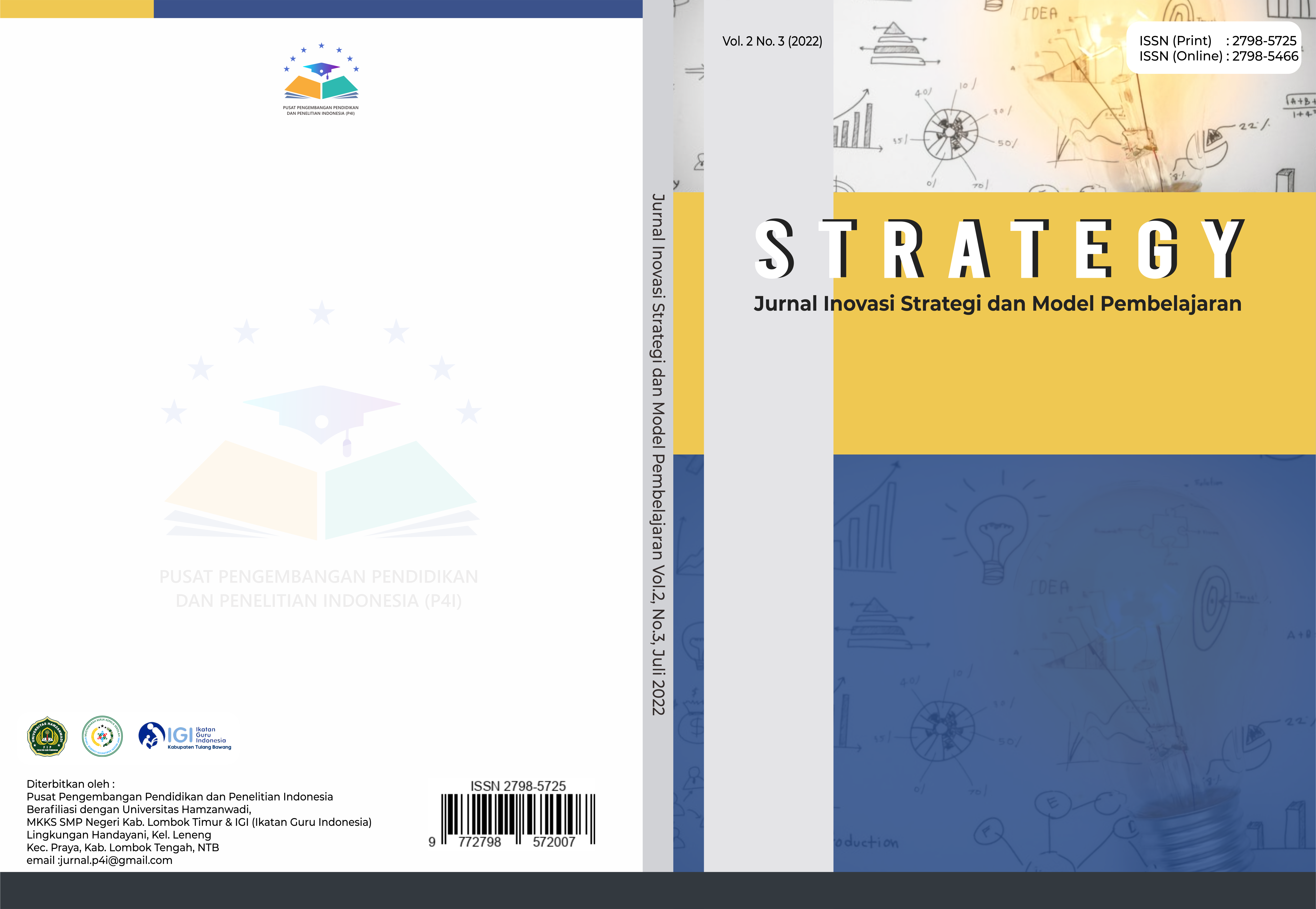PROBLEM POSING UNTUK MENINGKATKAN KEMAMPUAN BERPIKIR KREATIF
DOI:
https://doi.org/10.51878/strategi.v2i3.1468Keywords:
Problem Posing, Berpikir KreatifAbstract
This study aims to describe problem posing to improve creative thinking skills. This research is a descriptive-exploratory research. The subjects in this study were students of class VII.6 SMP Negeri 2 Toboali. The results showed that problem posing to improve creative thinking skills can train students in creative thinking. The number of questions that students make in problem posing activities is divided into three types of questions, the first type is a question that has the same characteristics, the second type is a question that has different characteristics, and the third type is an unusual question. The process of making questions is done by students by collecting and digging up existing information, then constructing them into questions. For the process of answering questions, students are carried out by processing information that is already known.
ABSTRAK
Penelitian ini bertujuan untuk mendeskripsikan problem posing untuk meningkatkan kemampuan berpikir kreatif. Penelitian ini merupakan penellitian deskriptif-eksploratif. Subjek dalam penelitian ini adalah siswa kelas VII.6 SMP Negeri 2 Toboali. Hasil penelitian menunjukan bahwa problem posing untuk meningkatkan kemampuan berpikir kreatif dapat melatih siswa dalam berpikir kreatif. Banyaknya soal yang dibuat siswa dalam kegiatan problem posing terbagi menjadi tiga tipe soal, tipe yang pertama adalah soal yang memiliki karakteristik sama, tipe yang kedua adalah soal yang memiliki karakteristik berbeda, dan tipe yang ketiga adalah soal yang tidak biasa. Proses membuat soal dilakukan siswa dengan mengumpulkan dan menggali informasi-informasi yang ada, kemudian dikonstruksi menjadi soal. Untuk proses menjawab soal, dilakukan siswa dengan mengolah informasi yang telah diketahui.
Downloads
References
Bakar & Norman, 2011. Secondary School Students’ Problem Posing Strategies: Implications To Secondary School Students’ Problem Posing Performances. Journal of Edupres, Volume 1 September 2011, Pages 1-8
Bonotto. 2010. Engaging Students in Mathematical Modelling and Problem Posing Activities. Journal of Mathematical Modelling and Application 2010, Vol. 1, No. 3.
Brunkalla, K. 2009. How To Intcrease Mathematical Creativity-An Experiment. The Montana Mathematics Enthusiast, ISSN 1551-3440, Vol. 6.
Cho & Abramovich. 2008. On Mathematical Problem Posing by Elementary Pre-teachers: The Case of Spreadsheets. Spreadsheets in Education (eJSiE): Vol. 3: Iss. 1, Article 1.
Darbaz & Cancoy, 2010. Effect Of A Problem Posing Based Problem Solving Instruction On Understanding Problem. Hacettepe Üniversitesi E?itim Fakültesi Dergisi (H. U. Journal of Education) 38: 11-24 [2010]. (online), (http://www.efdergi.hacettepe.edu.tr/english/abstracts/38/pdf/OSMAN%20CANKOY.pdf), diakses 22 Februari 2015.
Leikin, R. 2009. Exploring Mathematical Creativity using Multiple Solution Task. Creativity in Mathematics and the Education of Gifted Students, 129–145. (online), (http://mathgifted.org/publications/leikin(2009)multsol.pdf), diakses 22 Februari 2015.
Sanjaya, Wina. 2013. Strategi Pembelajaran. Jakarta: Kencana Prenandamedia Group.
Shih-Yeh Chen., Chin-Feng Lai., Ying-Hsun Lai & Yu-Sheng Su. (2019). Effect of project-based learning on development of students’ creative thinking. International Journal of Electrical Engineering & Education. 0(0), 1–19.diakses 15 agustus 2022
Silver, E.A. & Cai, J. (1996). An analysis of Aritmatic Problem Posing by Midlle School Students. Journal for Research In Mathematics Education, Vol. 27, No. 5 (Nov., 1996), pp. 521-539.
Silver, E.A., Downs, J.M., Leung, S.S. & Kenney, P.A. (1996). Posing Mathematical Problems: An Exploratory Study. Journal for Research in Mathematics Education. Vol. 27, No. 3 (May, 1996), pp. 293-309.
Silver, E.A. 1997. Fostering Creativity through Instruction Rich in Mathematical Problem Solving and Problem Posing. Zentralblatt fur Didaktik der Mathematik (ZDM) – The International Journal on Mathematics Education. (online), (www.emis.de/journals/ZDM/zdm973a3.pdf), diakses 16 Februari 2015.
Siswono, T. 2004. Identifikasi Proses Berpikir Kreatif Siswa dalam Pengajuan Masalah (Problem Posing) Matematika Berpandu dengan Model Wallas dan Creative Problem Solving (CPS). Buletin Pendidikan Matematika Volume 6 Nomor 2, Oktober 2004.
Subanji. 2013. Pembelajaran Matematika Kreatif dan Inovatif. Malang. UM Press.
Sugiyono. 2012. Metode Penelitian Pendidikan. Bandung: Alfabeta.
Xia, X., Lu, C. & Wang, B. 2008. Research on Mathematics Instruction Experiment Based Problem Posing. Journal of Mathematics Education December 2008, Vol. 1, No. 1, pp.153-163.
Downloads
Published
How to Cite
Issue
Section
License
Copyright (c) 2022 ISWANTO ISWANTO

This work is licensed under a Creative Commons Attribution-NonCommercial-ShareAlike 4.0 International License.















